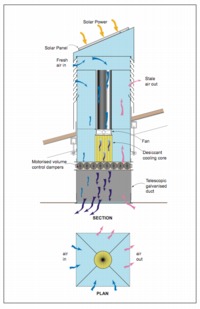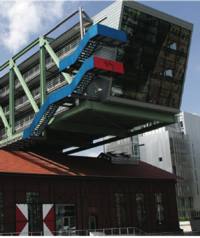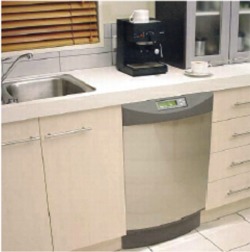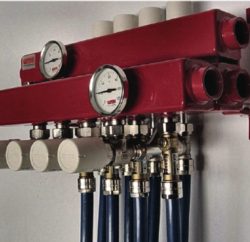Real ways to reduce carbon emissions
In among the bags of cement, scaffolding and bricks at this year’s Interbuild was a clutch of entries for the show’s awards — providing practical ways of reducing carbon emissions from buildings. They include a range of renewable-energy technologies and a product to achieve the thermal inertia of 10 cm of concrete in just 5 mm.Awareness of the need to reduce carbon-dioxide emissions from buildings permeates the construction industry. And the recent Interbuild exhibition at the National Exhibition Centre was no exception. Among nearly 150 entries for its exhibition awards, popularly referred to as the Interbuild Oscars, was a goodly clutch of products and concepts directly related to building services. Every one of them is significant, and to help you avoid missing something useful, the company names are highlighted in bold so it is easy to find where a new item starts. Selected as the best building-services product by a panel which was chaired by Michael Ankers (president of the Construction Products Association) and included CIBSE president David Hughes, Ruth Slavid (editor of AJ Specification) and Terry Smith (editor of Professional Builder) was the solar-power ventilation system launched by
Monodraught at the end of 2005. Sola-Boost is a solar-powered development of Monodraught’s long-establish Windcatcher natural-ventilation system which was launched in 1995. Over 5000 systems are now installed. The effectiveness of the Windcatcher is demonstrated by monitoring over the last six years showing temperatures exceeding 28°C in serviced space for only an average of 8 h a year.

Energy-free powered ventilation — Monodraught’s Sola-Boost.
Sola-Boost increases the effectiveness of this approach to ventilation by mounting a 40 W solar panel on top of a Windcatcher to power a 200 mm-diameter fan in the central core. The stronger the sunlight, the more power is available to the fan and the greater the ventilation possible. To maximises the performance of Sola-Boost, Monodraught’s electronics design engineer Simon Eastwood developed the PowerTrack control system, for which a patent application has been registered. PowerTrack defines three stages of operation. First, the fan does not run at all unless at least 5 V is available from the solar panel. Fan-assisted ventilation is provided until 14 V or more is available from the solar panel. The voltage to the fan is then increased to provided 2.5 times more ventilation. The judges’ commented, ‘Although simple in concept, Sola-Boost demonstrates that by employing new technologies with innovation, a product can be developed that can be applied either commercially or domestically. It has the advantage of being able to respond directly to weather conditions and to be self powered by solar energy.’ The exploitation of solar energy also features in the product that won the overall best new product award.
Solarcentury has developed solar-electrical and solar-thermal roof tiles that can directly replace conventional roof tiles. Each tile replaces four conventional roof tiles and closely resembles the rest of the roof, so that planning permission is not required. A typical installation of solar thermal tiles can generate more than 60% of the hot-water requirements of a 3-bedroom home.

Solarcentury has neatly integrated conventional roof tiles and solar photo-voltaic panels.
Michael Ankers, chairman of the judging panel, said, ‘Solarcentury has been leading the way in the use of solar power for quite some time and won the overall award because it continues to improve and innovate. It has taken solar power to the next level. The Complete Solar Roof is the logical extreme of this, with the entire roof generating heat and energy. The building fabric also becomes part of the services with an entry for the energy-saving category,
Solarwall’s air-heating system. These all-metal solar panels generate free heat from sunlight and are described as a way of helping companies meet their renewable-energy obligations by significantly reducing the heating required for most buildings.

Walls that generate free heat from sunlight — the Solarwall air-heating system.
The Solarwall system can be applied to commercial, industrial, multi-residential, schools and municipal buildings. It is now licensed to the CA Group and will be made in the UK. A new phase [the pun is deliberate] in using the mass of a building to limit internal temperatures was entered by
DuPont. The PCM panel adds to thermal mass by absorbing energy during a phase change at about 22°C — adding thermal mass to lightweight structures such as timber and steel frames.

Panels to add thermal mass to lightweight buildings developed by DuPont achieve the effect of 10 cm of concrete in just 5 mm.
Heating costs are said to be reduced by 10 to 15% and air-conditioning costs by 25 to 35%. Internal peak temperatures are reduced by 4 to 5 K, with room temperature regulated to around 25°C. PCM panels are just 5 mm thick but have the thermal inertia of about 10 cm of concrete. The use of renewable energy is the key to a ground-source heat pump developed by
Powergen. The HeatPlant uses a borehole to extract heat from the ground to provide water heating and space heating via an underfloor system or radiators. Running costs are said to be lower than a gas-fired condensing boiler. No flue is required, and there is no statutory annual-maintenance requirement. The life of the ground loop is expected to be 50 years.

Space heating and hot water using renewable energy — Powergen’s ground-source heat pump.
Powergen also entered its
Whispergen micro CHP unit which is intended to replace the gas boiler in a domestic central-heating system. It produces hot water in the same way as a boiler and about 1 kW of electricity, which is worth about £150 a year. The electricity can be exported to the grid if necessary.

CHP in the kitchen — Powergen’s Whispergen micro CHP unit can replace a domestic boiler and generate electricity.
An installation is said to reduce carbon-dioxide emissions by 1.5 t a year. Trials of Whispergen have been completed, and the product is available on the market. A unit can be installed beneath a kitchen work surface. Prompted by the growth of underfloor heating systems,
Thermo-Floor has developed a manifold that enables different circuits to provide heating or cooling as required. This manifold has separate flow circuits for heating and cooling and a combined return.

Enabling separate circuits of an underfloor heating system to provide hating and cooling at the same time is this manifold from Therma-Floor.
As if not satisfied with one award,
Monodraught also scooped the award for best interior product with its Sola-Vent system to provide both natural and artificial light and ventilation for interior rooms such as bathrooms with no windows. The SunPipe element of Sola-Vent provides energy-free lighting from dawn until dusk. Two compact fluorescent downlighters provide lighting at night. Ventilation is provided automatically using solar power to drive an extract fan which is triggered by a PIR when the bathroom is in use and over-runs by 15 minutes. Batteries that are recharged by the solar panel power the fan overnight. The fan is at the top of the extract duct to minimise noise in the bathroom. Monodraught intends to further the design so that the fluorescent lamps can be powered by stored electricity.

Self-contained natural and artificial lighting with energy-free ventilation for internal bathrooms — Monodraught’s Sola-vent.
There are two sizes of Sola-Vent, with SunPipes of 230 and 300 mm diameter and providing, respectively, 15 l/s and up to 60 l/s of ventilation. Prices start at £685. The judges’ summary of Sola-Vent was: ‘This well-thought-out product further develops the company’s SunPipe technology. It puts together in one good-looking element all the items needed for lighting and ventilating a bathroom, simplifying the ventilation and specification process.’
















